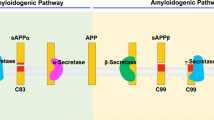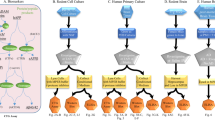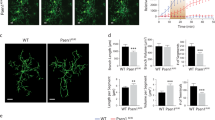Abstract
Alzheimer's disease is associated with increased production and aggregation of amyloid-β (Aβ) peptides1. Aβ peptides are derived from the amyloid precursor protein (APP) by sequential proteolysis, catalysed by the aspartyl protease BACE2, followed by presenilin-dependent γ-secretase cleavage3. Presenilin interacts with nicastrin4,5, APH-1 and PEN-2 (ref. 6), all of which are required for γ-secretase function. Presenilins also interact with α-catenin, β-catenin7,8 and glycogen synthase kinase-3β (GSK-3β)9,10,11, but a functional role for these proteins in γ-secretase activity has not been established. Here we show that therapeutic concentrations of lithium, a GSK-3 inhibitor12, block the production of Aβ peptides by interfering with APP cleavage at the γ-secretase step, but do not inhibit Notch processing. Importantly, lithium also blocks the accumulation of Aβ peptides in the brains of mice that overproduce APP. The target of lithium in this setting is GSK-3α, which is required for maximal processing of APP. Since GSK-3 also phosphorylates tau protein, the principal component of neurofibrillary tangles, inhibition of GSK-3α offers a new approach to reduce the formation of both amyloid plaques and neurofibrillary tangles, two pathological hallmarks of Alzheimer's disease.
This is a preview of subscription content, access via your institution
Access options
Subscribe to this journal
Receive 51 print issues and online access
$199.00 per year
only $3.90 per issue
Buy this article
- Purchase on Springer Link
- Instant access to full article PDF
Prices may be subject to local taxes which are calculated during checkout




Similar content being viewed by others
References
Selkoe, D. J. Presenilin, Notch, and the genesis and treatment of Alzheimer's disease. Proc. Natl Acad. Sci. USA 98, 11039–11041 (2001)
Vassar, R. et al. β-Secretase cleavage of Alzheimer's amyloid precursor protein by the transmembrane aspartic protease BACE. Science 286, 735–741 (1999)
De Strooper, B. et al. Deficiency of presenilin-1 inhibits the normal cleavage of amyloid precursor protein. Nature 391, 387–390 (1998)
Esler, W. P. et al. Activity-dependent isolation of the presenilin–γ-secretase complex reveals nicastrin and a γ secretase substrate. Proc. Natl Acad. Sci. USA 99, 2720–2725 (2002)
Edbauer, D., Winkler, E., Haass, C. & Steiner, H. Presenilin and nicastrin regulate each other and determine amyloid β-peptide production via complex formation. Proc. Natl Acad. Sci. USA 99, 8666–8671 (2002)
Francis, R. et al. aph-1 and pen-2 are required for Notch pathway signalling, γ-secretase cleavage of βAPP, and presenilin protein accumulation. Dev. Cell 3, 85–97 (2002)
Soriano, S. et al. Presenilin 1 negatively regulates β-catenin/T cell factor/lymphoid enhancer factor-1 signalling independently of β-amyloid precursor protein and notch processing. J. Cell Biol. 152, 785–794 (2001)
Yu, G. et al. Nicastrin modulates presenilin-mediated notch/glp-1 signal transduction and βAPP processing. Nature 407, 48–54 (2000)
Takashima, A. et al. Presenilin 1 associates with glycogen synthase kinase-3β and its substrate tau. Proc. Natl Acad. Sci. USA 95, 9637–9641 (1998)
Kang, D. E. et al. Presenilin 1 facilitates the constitutive turnover of β-catenin: differential activity of Alzheimer's disease-linked PS1 mutants in the β-catenin-signalling pathway. J. Neurosci. 19, 4229–4237 (1999)
Kang, D. E. et al. Presenilin couples the paired phosphorylation of β-catenin independent of axin: implications for β-catenin activation in tumorigenesis. Cell 110, 751–762 (2002)
Phiel, C. J. & Klein, P. S. Molecular targets of lithium action. Annu. Rev. Pharmacol. Toxicol. 41, 789–813 (2001)
Klein, P. S. & Melton, D. A. A molecular mechanism for the effect of lithium on development. Proc. Natl Acad. Sci. USA 93, 8455–8459 (1996)
Sun, X. et al. Lithium inhibits amyloid secretion in COS7 cells transfected with amyloid precursor protein C100. Neurosci. Lett. 321, 61–64 (2002)
De Strooper, B. et al. A presenilin-1-dependent γ-secretase-like protease mediates release of Notch intracellular domain. Nature 398, 518–522 (1999)
Wolfe, M. S. et al. Two transmembrane aspartates in presenilin-1 required for presenilin endoproteolysis and γ-secretase activity. Nature 398, 513–517 (1999)
Schroeter, E. H., Kisslinger, J. A. & Kopan, R. Notch-1 signalling requires ligand-induced proteolytic release of intracellular domain. Nature 393, 382–386 (1998)
Bain, J., McLaughlan, H., Elliott, M. & Cohen, P. The specificities of protein kinase inhibitors—an update. Biochem. J. 371, 199–204 (2003)
Elbashir, S. M. et al. Duplexes of 21-nucleotide RNAs mediate RNA interference in cultured mammalian cells. Nature 411, 494–498 (2001)
Hoeflich, K. P. et al. Requirement for glycogen synthase kinase-3β in cell survival and NF-κB activation. Nature 406, 86–90 (2000)
Siman, R. et al. Presenilin-1 P264L knock-in mutation: differential effects on Aβ production, amyloid deposition, and neuronal vulnerability. J. Neurosci. 20, 8717–8726 (2000)
Kirschenbaum, F., Hsu, S. C., Cordell, B. & McCarthy, J. V. Substitution of a glycogen synthase kinase-3β phosphorylation site in presenilin 1 separates presenilin function from β-catenin signaling. J. Biol. Chem. 276, 7366–7375 (2001)
Weggen, S. et al. A subset of NSAIDs lower amyloidogenic Aβ42 independently of cyclooxygenase activity. Nature 414, 212–216 (2001)
Alvarez, G. et al. Regulation of tau phosphorylation and protection against β-amyloid-induced neurodegeneration by lithium. Possible implications for Alzheimer's disease. Bipolar Disord. 4, 153–165 (2002)
Forman, M. S., Cook, D. G., Leight, S., Doms, R. W. & Lee, V. M.-Y. Differential effects of the Swedish mutant amyloid precursor protein on β-amyloid accumulation and secretion in neurons and nonneuronal cells. J. Biol. Chem. 272, 32247–32253 (1997)
Pleasure, S. J., Page, C. & Lee, V. M.-Y. Pure, postmitotic, polarized human neurons derived from NTera 2 cells provide a system for expressing exogenous proteins in terminally differentiated neurons. J. Neurosci. 12, 1802–1815 (1992)
Suzuki, N. et al. An increased percentage of long amyloid β protein secreted by familial amyloid β protein precursor (βAPP717) mutants. Science 264, 1336–1340 (1994)
Turner, R. S., Suzuki, N., Chyung, A. S., Younkin, S. G. & Lee, V. M.-Y. Amyloids β40 and β42 are generated intracellularly in cultured human neurons and their secretion increases with maturation. J. Biol. Chem. 271, 8966–8970 (1996)
Cook, D. G. et al. Alzheimer's Aβ(1–42) is generated in the endoplasmic reticulum/intermediate compartment of NT2N cells. Nature Med. 3, 1021–1023 (1997)
Wilson, C. A., Doms, R. W., Zheng, H. & Lee, V. M.-Y. Presenilins are not required for Aβ42 production in the early secretory pathway. Nature Neurosci. 5, 849–855 (2002)
Acknowledgements
We wish to thank R. Doms for critical reading of the manuscript, and T. Kadesch, J. Yang, G. Wertheim, K. Phiel and members of the Klein, Lee and Doms laboratories for helpful discussions. We are grateful to J. Woodgett, R. Kopan, B. Gumbiner, K. Kinzler and B. Vogelstein for plasmids, S. Sisodia for CHO-APP695 cells, and D. Flood for PS1P264L knock-in mice. Monoclonal antibodies for the Aβ sandwich ELISA were provided by N. Suzuki and Tekeda Pharmaceuticals. C.A.W. was a Howard Hughes Predoctoral Fellow. This work was supported by grants from the National Institute on Aging (to V.M.-Y.L.) and the National Institute of Mental Health (to P.S.K.).
Author information
Authors and Affiliations
Corresponding author
Ethics declarations
Competing interests
The authors declare that they have no competing financial interests.
Rights and permissions
About this article
Cite this article
Phiel, C., Wilson, C., Lee, VY. et al. GSK-3α regulates production of Alzheimer's disease amyloid-β peptides. Nature 423, 435–439 (2003). https://doi.org/10.1038/nature01640
Received:
Accepted:
Issue Date:
DOI: https://doi.org/10.1038/nature01640
This article is cited by
-
Genome-Related Mechanisms Contributing to Differences in Alzheimer’s Disease Incidence Between White and Black Older US Adults
Journal of Racial and Ethnic Health Disparities (2024)
-
Potential Use of the Cholesterol Transfer Inhibitor U18666A as a Potent Research Tool for the Study of Cholesterol Mechanisms in Neurodegenerative Disorders
Molecular Neurobiology (2023)
-
Understanding Glycogen Synthase Kinase-3: A Novel Avenue for Alzheimer’s Disease
Molecular Neurobiology (2023)
-
PET molecular imaging for pathophysiological visualization in Alzheimer’s disease
European Journal of Nuclear Medicine and Molecular Imaging (2023)
-
Circadian clocks, cognition, and Alzheimer’s disease: synaptic mechanisms, signaling effectors, and chronotherapeutics
Molecular Neurodegeneration (2022)
Comments
By submitting a comment you agree to abide by our Terms and Community Guidelines. If you find something abusive or that does not comply with our terms or guidelines please flag it as inappropriate.



